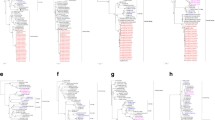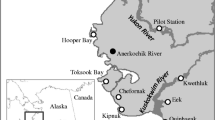Abstract
In August 2014, a low-pathogenic H7N3 influenza A virus was isolated from pheasants at a New Jersey gamebird farm and hunting preserve. In this study, we use phylogenetic analyses and calculations of genetic similarity to gain inference into the genetic ancestry of this virus and to identify potential routes of transmission. Results of maximum-likelihood (ML) and maximum-clade-credibility (MCC) phylogenetic analyses provide evidence that A/pheasant/New Jersey/26996-2/2014 (H7N3) had closely related H7 hemagglutinin (HA) and N3 neuraminidase (NA) gene segments as compared to influenza A viruses circulating among wild waterfowl in the central and eastern USA. The estimated time of the most recent common ancestry (TMRCA) between the pheasant virus and those most closely related from wild waterfowl was early 2013 for both the H7 HA and N3 NA gene segments. None of the viruses from waterfowl identified as being most closely related to A/pheasant/New Jersey/26996-2/2014 at the HA and NA gene segments in ML and MCC phylogenetic analyses shared ≥99 % nucleotide sequence identity for internal gene segment sequences. This result indicates that specific viral strains identified in this study as being closely related to the HA and NA gene segments of A/pheasant/New Jersey/26996-2/2014 were not the direct predecessors of the etiological agent identified during the New Jersey outbreak. However, the recent common ancestry of the H7 and N3 gene segments of waterfowl-origin viruses and the virus isolated from pheasants suggests that viral diversity maintained in wild waterfowl likely played an important role in the emergence of A/pheasant/New Jersey/26996-2/2014.




Similar content being viewed by others
References
Webster RG, Bean WJ, Gorman OT, Chambers TM, Kawaoka Y (1992) Evolution and ecology of influenza A viruses. Microbiol Rev 56:152–179
Claas ECJ, Osterhaus ADME, van Beek R, De Jong JC, Rimmelzwaan GF, Senne DA, Krauss S, Shortridge KF, Webster RG (1998) Human influenza A H5N1 virus related to a highly pathogenic avian influenza virus. Lancet 351:472–477
Koopmans M, Wilbrink B, Conyn M, Natrop G, van der Nat H, Vennema H, Meijer A, van Steenbergen J, Fouchier R, Oseterhaus A, Bosman A (2004) Transmission of H7N7 avian influenza A virus to human beings during a large outbreak in commercial poultry farms in the Netherlands. Lancet 363:587–593
Gao R, Cao B, Hu Y, Feng Z, Wang D, Hu W, Chen J, Jie Z, Qiu H, Xu K, Xu X, Lu H, Zhu W, Gao Z, Xiang N, Shen Y, He Z, Gu Y, Zhang Z, Yang Y, Zhao X, Zhou L, Li X, Zou S, Zhang Y, Li X, Yang L, Guo J, Dong J, Li Q, Dong L, Zhu Y, Bai T, Wang S, Hao P, Yang W, Zhang Y, Han J, Yu H, Li D, Gao GF, Wu G, Wang Y, Yuan Z, Shu Y (2013) Human infection with a novel avian-origin influenza A (H7N9) virus. N Engl J Med 368:1888–1897
Saito T, Horimoto T, Kawaoka Y, Senne DA, Webster RG (1994) Emergence of a potentially pathogenic H5N2 influenza virus in chickens. Virology 201:277–284
Suarez DL, Senne DA (2000) Sequence analysis of related low-pathogenic and highly pathogenic H5N2 avian influenza isolates from United States live bird markets and poultry farms from 1983 to 1989. Avian Dis 44:356–364
Spackman E, Senne DA, Davison S, Suarez DL (2003) Sequence analysis of recent H7 avian influenza viruses associated with three different outbreaks in commercial poultry in the United States. J Virol 77:13399–13402
Lee CW, Swayne DE, Linares JA, Senne DA, Suarez DL (2005) H5N2 avian influenza outbreak in Texas in 2004: the first highly pathogenic strain in the United States in 20 years? J Virol 79:11412–11421
Lebarbenchon C, Pedersen JC, Sreevatsan S, Ramey AM, Dugan VG, Halpin RA, Ferro PJ, Lupiani B, Enomoto S, Poulson RL, Smeltzer M, Cardona CJ, Tompkins SM, Wentwoth DE, Stallknecht DE, Brown JD (2015) H7N9 Influenza A virus in Turkeys in Minnesota. J Gen Virol 96:269–276
Ip HS, Torchetti MK, Crespo R, Kohrs P, DeBruyn P, Mansfield KG, Baszler T, Badcoe L, Bodenstein B, Shearn-Boschler V, Killian ML, Pedersen JC, Hines N, Gidlewski T, DeLiberto T, Sleeman JM (2015) Novel Eurasian highly pathogenic avian influenza A H5 viruses in wild birds, Washington, USA, 2014. Emerg Infect Dis 21:886–890
Pasick J, Berhane Y, Joseph T, Bowes V, Hisanaga T, Handel K, Alexandersen S (2014) Reassortant highly pathogenic influenza A H5N2 virus containing gene segments related to Eurasian H5N8 in British Columbia, Canada. Sci Rep 5:9484
Ramey AM, Reeves AB, TeSlaa JL, Nashold S, Donnelly T, Bahl J, Hall JS (2016) Evidence for common ancestry among viruses isolated from wild birds in Beringia and highly pathogenic intercontinental reassortant H5N1 and H5N2 influenza A viruses. Infect Genet Evol 40:176–185
Lebarbenchon C, Stallknecht DE (2011) Host shifts and molecular evolution of H7 avian influenza virus hemagglutinin. Virol J 8:328
OIE (2014) Follow-up report No. 3 on occurrence of low pathogenic avian influenza (poultry), United States of America. http://www.oie.int/wahis_2/public/wahid.php/Reviewreport/Review?reportid=16135. Accessed Nov 2015
Spackman E (ed) (2014) Animal influenza virus. Springer, New York
Bao Y, Bolotov P, Dernovoy D, Kiryutin B, Zaslavsky L, Tatusova T, Ostell J, Lipman D (2008) The influenza virus resource at the National Center for Biotechnology Information. J Virol 82:596–601
Stallknecht DE, Shane SM, Zwank PJ, Senne DA, Kearney MT (1990) Avian influenza viruses from migratory and resident ducks of coastal Louisiana. Avian Dis 34:398–405
Ramey AM, Reeves AB, Sonsthagen SA, TeSlaa JL, Nashold S, Donnelly T, Casler B, Hall JS (2015) Dispersal of H9N2 influenza A viruses between East Asia and North America by wild birds. Virology 482:79–83
Tamura K, Stecher G, Peterson D, Filipski A, Kumar S (2013) MEGA6: molecular evolutionary genetics analysis version 6.0. Mol Biol Evol 30:2725–2729
Drummond AJ, Rambaut A (2007) BEAST: Bayesian evolutionary analysis by sampling trees. BMC Evol Biol 7:214
Shapiro B, Rambaut A, Drummon AJ (2006) Choosing appropriate substitution models for the phylogenetic analysis of protein-coding sequences. Mol Biol Evol 23:7–9
Drummond AJ, Rambaut A, Shapiro B, Pybus OG (2005) Bayesian coalescent inference of past population dynamics from molecular sequences. Mol Biol Evol 22:1185–1192
Humberd J, Guan Y, Webster RG (2006) Comparison of the replication of influenza A viruses in Chinese ring-necked pheasants and chukar partridges. J Virol 80:2151–2161
Krauss S, Stucker KM, Schobel SA, Danner A, Friedman K, Knowles JP, Kayali G, Niles LJ, Dey AD, Raven G, Pryor P (2015) Long-term surveillance of H7 influenza viruses in American wild aquatic birds: Are the H7N3 influenza viruses in wild birds the precursors of highly pathogenic strains in domestic poultry? Emerg Microbes Infect 4:e35
Acknowledgements
We appreciate field and laboratory support by Nick Davis-Fields, Alinde Fojtik, Clara Kienzle, and John Reed. We thank John Pearce, Mary Pantin-Jackwood, and two anonymous reviewers for providing critical reviews.
Author information
Authors and Affiliations
Corresponding author
Ethics declarations
This project was Funded by the U.S. Geological Survey through the Wildlife Program of the Ecosystems Mission area, the National Institute of Allergy and Infectious Diseases, National Institutes of Health, Department of Health and Human Services, under contract HHSN272201400006C., and by ‘chaire mixte: institut national de la santé et de la recherche médicale – université de La Réunion’. None of the authors have any financial interests or conflict of interest with this article. Any use of trade names is for descriptive purposes only and does not imply endorsement by the U.S. Government. All applicable international, national, and/or institutional guidelines for the care and use of animals were followed.
Electronic supplementary material
Below is the link to the electronic supplementary material.
705_2016_2947_MOESM1_ESM.pdf
Supplemental Figure S1 Maximum-likelihood phylogenetic tree depicting the inferred relationship among 501 sequences for H7 hemagglutinin gene segments derived from influenza A viruses isolated from wild and domestic birds in North America. Branch tips for sequences selected for maximum-clade-credibility analysis are colored red. Bootstrap support values > 70 are presented. Sequences generated for this study are indicated in bold font. The position of the sequence for A/pheasant/New Jersey/26996-2/2014 (H7N3) is indicated with an asterisk (*). Supplemental Figure S2. Maximum-likelihood phylogenetic tree depicting the inferred relationship among 501 sequences for N3 neuraminidase gene segments derived from influenza A viruses isolated from wild and domestic birds in North America. Branch tips for sequences selected for maximum-clade-credibility analysis are colored red. Bootstrap support values > 70 are presented. Sequences determined in this study are indicated in bold font. The position of the sequence for A/pheasant/New Jersey/26996-2/2014 (H7N3) is indicated with an asterisk (*). Supplemental Figure S3. Maximum-clade-credibility tree depicting the inferred ancestry of sequences of PB2 gene segments derived from influenza A viruses isolated from wild and domestic birds in North America. Posterior probability values > 0.7 are reported. Grey bars indicate the 95% HPD for the time of the most recent common ancestors. Sequences generated for this study are indicated in bold. The branch tip for A/pheasant/New Jersey/26996-2/2014 (H7N3) is colored red. Supplemental Figure S4. Maximum-clade-credibility tree depicting the inferred ancestry of sequences of PB1 gene segments derived from influenza A viruses isolated from wild and domestic birds in North America. Posterior probability values > 0.7 are reported. Grey bars indicate the 95% HPD for the time of the most recent common ancestors. Sequences generated for this study are indicated in bold. The branch tip for A/pheasant/New Jersey/26996-2/2014 (H7N3) is colored red. Supplemental Figure S5. Maximum-clade-credibility tree depicting the inferred ancestry of sequences of PA gene segments derived from influenza A viruses isolated from wild and domestic birds in North America. Posterior probability values > 0.7 are reported. Grey bars indicate the 95% HPD for the time of the most recent common ancestors. Sequences generated for this study are indicated in bold. The branch tip for A/pheasant/New Jersey/26996-2/2014 (H7N3) is colored red. Supplemental Figure S6. Maximum-clade-credibility tree depicting the inferred ancestry of sequences of NP gene segments derived from influenza A viruses isolated from wild and domestic birds in North America. Posterior probability values > 0.7 are reported. Grey bars indicate the 95% HPD for the time of the most recent common ancestors. Sequences generated for this study are indicated in bold. The branch tip for A/pheasant/New Jersey/26996-2/2014 (H7N3) is colored red. Supplemental Figure S7. Maximum-clade-credibility tree depicting the inferred ancestry of sequences of M gene segments derived from influenza A viruses isolated from wild and domestic birds in North America. Posterior probability values > 0.7 are reported. Grey bars indicate the 95% HPD for the time of the most recent common ancestors. Sequences generated for this study are indicated in bold. The branch tip for A/pheasant/New Jersey/26996-2/2014 (H7N3) is colored red. Supplemental Figure S8. Maximum-clade-credibility tree depicting the inferred ancestry of sequences of NS gene segments derived from influenza A viruses isolated from wild and domestic birds in North America. Posterior probability values > 0.7 are reported. Grey bars indicate the 95% HPD for the time of the most recent common ancestors. Sequences generated for this study are indicated in bold. The branch tip for A/pheasant/New Jersey/26996-2/2014 (H7N3) is colored red. (PDF 1246 kb)
Rights and permissions
About this article
Cite this article
Ramey, A.M., Kim Torchetti, M., Poulson, R.L. et al. Evidence for wild waterfowl origin of H7N3 influenza A virus detected in captive-reared New Jersey pheasants. Arch Virol 161, 2519–2526 (2016). https://doi.org/10.1007/s00705-016-2947-z
Received:
Accepted:
Published:
Issue Date:
DOI: https://doi.org/10.1007/s00705-016-2947-z




